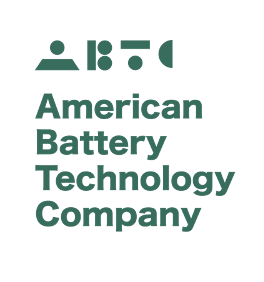American Battery Metals Corporation Responds to Department of Energy Request for Information Regarding Risks in the High-Capacity Batteries Supply Chain
American Battery Metals Corporation (OTCQB:ABML) has responded to the Department of Energy's Request for Information on risks in the high-capacity battery supply chain. The company identified significant risks including geopolitical dependency for battery materials, climate risks from outdated recycling methods, and a lack of transport infrastructure. Proposals were made to create a new non-waste classification for lithium-ion batteries and to allow regulatory waivers to enhance recycling efforts. The company aims to become a leader in lithium-ion battery recycling, addressing both environmental and supply chain challenges.
- American Battery Technology Company is positioning itself as a leader in lithium-ion battery recycling.
- The pilot facility in Nevada will process 20,000 metric tons of lithium batteries per year, one of the largest globally.
- Proposed policy solutions aim to improve domestic sourcing of battery metals and enhance environmental outcomes.
- The U.S. is currently heavily reliant on foreign sources for approximately 99% of key battery metals.
- Existing regulatory frameworks hinder the efficient implementation of lithium-ion battery recycling technologies.
Insights
Analyzing...
Proposes Policy Solutions to Scale a Circular Economy for Battery Metals in the United States
INCLINE VILLAGE, NV / ACCESSWIRE / April 16, 2021 / American Battery Metals Corporation (OTCQB:ABML) (the "Company"), an American-owned lithium-ion battery recycling and advanced battery metal extraction technology company with extensive mineral resources in Nevada, which is in the process of changing its name to American Battery Technology Company (ABTC), responded to Department of Energy's Request for Information on "Risks in the High-Capacity Batteries, including Electric Vehicles Batteries Supply Chain." The Company outlined risks inherent in the current battery critical materials supply chain; identified recycling of lithium batteries using next generation extraction technologies as the fastest, most economical and environmentally-friendly way to increase domestic sources of critical battery materials; and proposed policy solutions to scale a circular economy for battery metals in ways that work for local communities, environment, and companies alike. The Company is pleased to share below portions of its DoE RFI response. The full RFI response can be found here.

Risks to Battery Critical Material Supply Chains that American Battery Technology Company is helping to address:
- Geopolitical Risk: Global demand for battery metals is expected to grow over ten-fold by 2030 with a total market value of approximately
$100B /year. However, the current battery metals industry in the United States is not able to meet this growing demand at home. Approximately99% of lithium, nickel, cobalt, and manganese battery metals are sourced from a handful of foreign countries. American Battery Technology Company is addressing this gap by scaling to become a home-grown leader in lithium-ion battery recycling. Our pilot facility in Nevada, currently in the permitting and construction phase, will process 20,000 metric tons of lithium batteries per year from electric vehicles, consumer electronics, energy storage applications and manufacturing waste - making it one of the largest facilities in the world. - Climate Risks from Outdated Recycling Methods: Outdated battery recycling methods pose climate risks in the high-capacity battery supply chain as they generate large amounts of air pollution in the form of fluorine, phosphorous, sulfur-based, and carbon dioxide emissions. Next generation battery recycling methods, such as those developed by American Battery Technology Company and others, are improving environmental outcomes through the use of mechanical and automated reverse battery manufacturing processes combined with targeted selective cathode grade metal extractions. These new technologies avoid air and liquid pollutant emissions through strategic design and avoidance of high-temperature operations, while generating minimal waste. Direct greenhouse gas emissions from recycling of battery cell components using the new mechanical-hydrometallurgical recycling processes yield less than 5 pounds of carbon dioxide per ton of lithium-ion battery feedstock recycled, compared to an estimated 1,100 or more pounds of carbon dioxide per ton of feedstock using outdated pyrometallurgy recycling processes.
- Lack of Collection and Transport Infrastructure: The safe transportation and storage of lithium-ion batteries is critical to the success of the battery recycling supply chain and to stemming the tide of lithium-ion batteries that end up in landfills and as unchecked fire hazards in local communities. The current domestic regulatory framework for transporting and storing batteries is a challenge for the industry and local communities alike, and one that must be considered for streamlining by policy makers. American Battery Technology Company is sharing its technical knowledge about lithium battery safe handling best practices with policy makers to develop frameworks that better enable transport and storage of lithium batteries while protecting climate and community.
- Regulatory Frameworks: Existing regulatory frameworks, such as the Resource Conservation and Recovery Act (RCRA), were implemented at a time when lithium battery manufacturing and recycling had not yet been fully conceived of at pilot or commercial scales. Although breakthroughs in lithium-ion battery recycling technology, such as those developed by American Battery Technology Company, allow for faster, economical, and environmentally superior sourcing of critical battery metals, regulatory ambiguities around lithium-ion battery feedstock classification (as hazardous and/or universal waste) and inconsistencies across state lines inhibit nimble implementation of these technologies at scale.
Policy Proposals to Scale Lithium Battery Recycling in the United States:
- Create a new non-waste classification category for lithium-ion batteries, separate from the hazardous waste designation. This new category will lead to better environmental outcomes. There will be increased sustainability of battery materials in the market, and there will be increased domestic sourcing of battery metals.
- Allow states RCRA and hazardous materials regulations enforcement waivers for storage, transport, and recycling of lithium-ion batteries that are meant for recycling. When managed correctly, lithium-ion batteries are safe, and deserving of this new category. Adhering to best management practices across industries will ensure safe transportation, handling, and processing during the recycling process. Clarification of these practices should be established in partnerships across government, community, and industry to ensure they have broad support from an environmental perspective.
American Battery Technology Company will continue its policy work to ensure the domestic battery supply chain reaches its full potential and that American manufacturers can bring innovation, jobs and secure supply chains to the growing field of electric vehicles - in a way that works for local communities, the environment, and homegrown companies at the same time.
About American Battery Metals Corporation
American Battery Technology Company is uniquely positioned to supply battery metals through its three divisions: lithium-ion battery recycling, extraction technology, and primary resources. The Company recently announced the groundbreaking of its lithium-ion battery recycling facility in Fernley, NV, and issued a recent shareholder letter outlining achievements of the past year.
American Battery Technology Company has built a clean technology platform that increases production of primary metals used in the batteries that power electric cars, grid storage applications, consumer electronics and tools. The green platform creates a circular economy for battery metals that champions ethical and environmentally sustainable sourcing of critical materials.
For more information, please visit: www.americanbatterytechnology.com
Forward-Looking Statements
This press release contains "forward-looking statements" within the meaning of the safe harbor provisions of the U.S. Private Securities Litigation Reform Act of 1995. All statements, other than statements of historical fact, including those with respect to the expected project economics for Western Nevada Basin (Railroad Valley), including estimates of life of mine, average production, cash costs, AISC, initial CAPEX, sustaining CAPEX, pre-tax IRR, pre-tax NPV, net cash flows and recovery rates, the impact of self-mining versus contract mining, the timing to obtain necessary permits, the submission of the project for final investment approval and the timing of initial gold production after investment approval and full financing, metallurgy and processing expectations, the mineral resource estimate, expectations regarding the ability to expand the mineral resource through future drilling, ongoing work to be conducted at the Western Nevada Basin (Railroad Valley), and the potential results of such efforts, the potential commissioning of a Pre-Feasibility study and the effects on timing of the project, are "forward-looking statements." Although the Company's management believes that such forward-looking statements are reasonable, it cannot guarantee that such expectations are, or will be, correct. These forward-looking statements involve a number of risks and uncertainties, which could cause the Company's future results to differ materially from those anticipated. Potential risks and uncertainties include, among others, interpretations or reinterpretations of geologic information, unfavorable exploration results, inability to obtain permits required for future exploration, development or production, general economic conditions and conditions affecting the industries in which the Company operates; the uncertainty of regulatory requirements and approvals; fluctuating mineral and commodity prices, final investment approval and the ability to obtain necessary financing on acceptable terms or at all. Additional information regarding the factors that may cause actual results to differ materially from these forward-looking statements is available in the Company's filings with the Securities and Exchange Commission, including the Annual Report on Form 10-K for the year ended June 30, 2020. The Company assumes no obligation to update any of the information contained or referenced in this press release.
Contact Information
P: 775-473-4744
info@batterymetals.com
SOURCE: American Battery Metals Corporation
View source version on accesswire.com:
https://www.accesswire.com/640713/American-Battery-Metals-Corporation-Responds-to-Department-of-Energy-Request-for-Information-Regarding-Risks-in-the-High-Capacity-Batteries-Supply-Chain







